There’s been a lot of press lately about raising resilient children. Educators and parents are noticing that kids aren’t able to recover from disappointment, or problem-solve solutions to obstacles. A culprit is the trend of adults to jump in and assist during even the smallest of challenges. To instill resiliency, we’re advised to give children the freedom to make mistakes. We need to let our kids discover that they can handle difficult situations using their own inner resources. We horse owners could learn from this resiliency movement.
Most of our horses live constrained lives. We tell them what to do and exactly how to do it. We tell them not to react when things scare them, to stand still unless told to do otherwise, and to socially interact in restricted and human-centric ways. In many riding sports, we tell them precisely where each footfall should land, and how to move to get there. Like over-protected and micro-managed children, they become compliant, but have no ability to deal with anything that occurs off script.
Many owners like passive horses! Having compliant mounts isn’t a bad thing. It feels safe to ride and handle them. But there’s a wide gulf in behavior between a horse that’s acquiescent because they have to be, and a horse that thinks through the situation and is calm because they’ve determined that that’s the best solution.
We can train our horses to be unruffled in the face of the unknown. There are a few ways to do that, and they’ve been well-studied by behavior scientists. Punishment is the seemingly easiest method to stop any startled response. The punished horse appears to behave safely afterwards, but there are many downsides to this (I promise a post on the pitfalls of punishment soon!) Better, is to use desensitizing and counter-conditioning, which I’ve written about in this blogpost.
I use desensitizing and counter-conditioning all the time with horses, but I also use something else – I let my horses think. I give them the freedom to make sense of what startles them. (Within reason! Here, Tonka is surprised by the shadow of snow falling off of the roof. I keep him from taking off in a panic by pulling him back with the lead rope, but I don’t yank him around and punish him for the sudden lunge forward.)
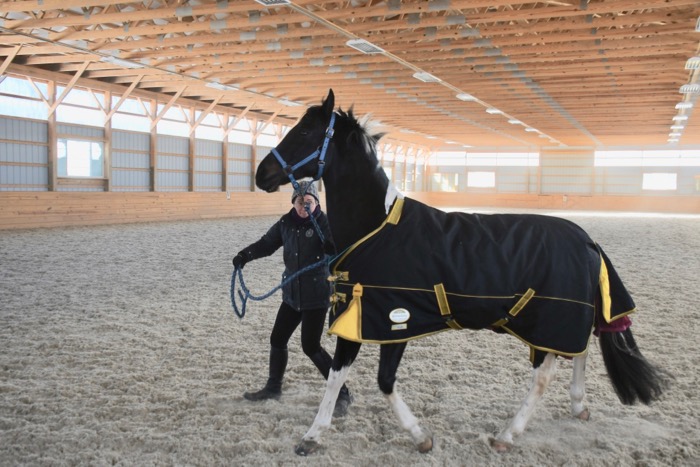
Although I want horses to think, I don’t want them to feel that they’re left all on their own. Horses are herd animals and get confidence from their friends. I let the horses know that I’m in this with them. I look at what they look at. If I know that it’s nothing that’s going to hurt us, I convey calm certainty that we’re safe. If it’s a bear, I thank my horse and we head the other direction!
Here’s an example.
It’s New England. There’s snow on the roof of the arena. It slides off, right past the windows! It makes rustling noises on the roof as it goes, and a thwump when it hits the ground. (See it flying past the window on the right?)

A horse is capable of putting 2 + 2 together. Before we go into the ring, I let Tonka watch the snow slip off of the roof.
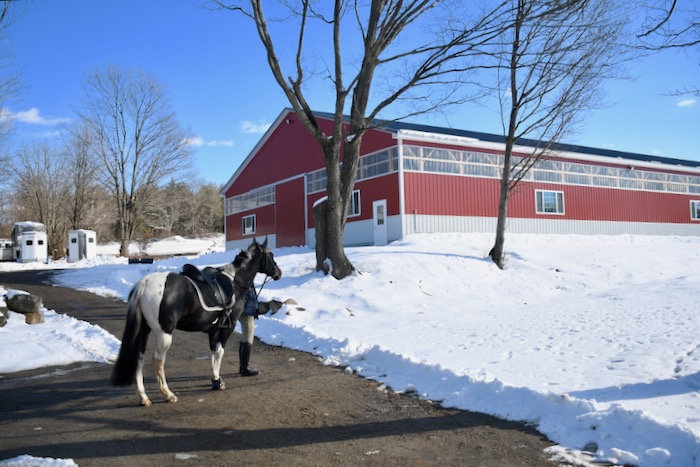
We do this far enough away that he doesn’t feel threatened. Tonka sees the snow slide. He hears the noise it makes. He understands that one causes the other, and he knows that it’s not going to hurt him. We go into the arena without fear.
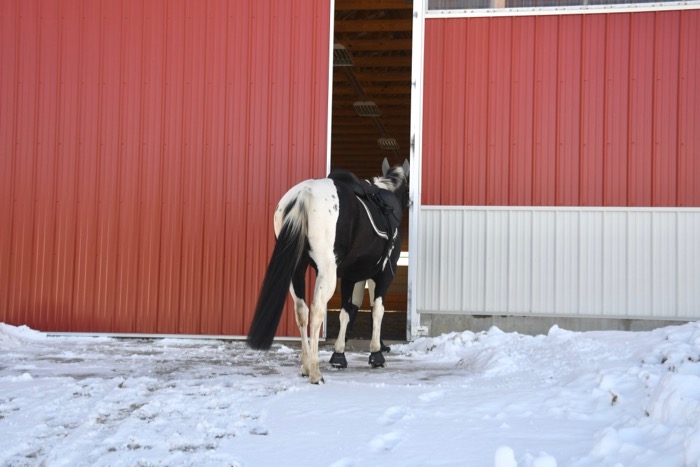
However, horses (most animals) don’t generalize. That means that although Tonka has become blasé to snow falling off the roof on the right side of the arena, he hasn’t determined that snow falling on the left is also safe.
So, on a day where the noise and movement was coming from that other side, we took a moment to look.
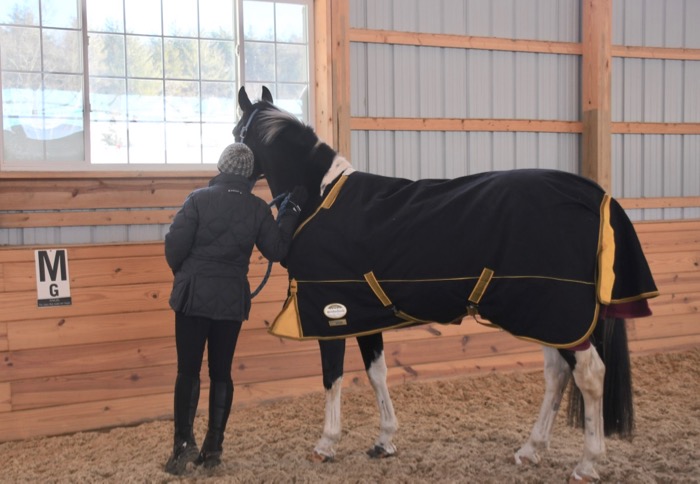
I swear I could hear Tonka say, Oh, I get it! There’s snow over here, too!
Unfortunately, knowing that the snow is sliding off of the roof doesn’t mean that sudden movement in a window isn’t going to startle us. Sometimes we both jump! When that happens, instead of tensing and restricting Tonka, which would confirm to him that there’s something to worry about, I reach forward and stroke him. I let him know that I’ve already problem-solved this, and that he can rely on me, but that he’s free to make his own assessment.
There’s a big difference between being told by someone else, Don’t be scared, (or the dreaded words from the dentist, This won’t hurt) and having that inner voice that says, I’ve got it. No problem.

In this example, Tonka decided to tune into me and to ignore the snow. With self-confidence. That’s being resilient.
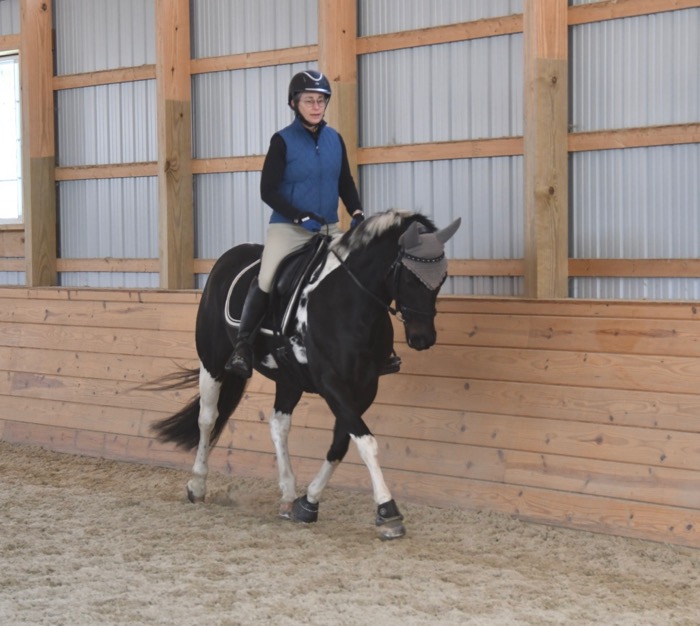


I love that you talked about this Terry! I think it’s important to build confidence through dealing with different sights and sounds. At our barn we will run and get our horses if there is something different going on. Weather it’s tree work, painters at a house next door, or a mom and child riding bikes on the road we all view it as a learning experience. I’m taking my horse to our first clinic this summer so we will see if all the exposure to new things has paid off.
You are at the BEST barn! I’m sure your horse will totally enjoy the clinic.
Beautiful photos of Tonka keeping cool and figuring out what’s going on, and then doing his work calmly and well. THAT’s positive teaching and communication, both parties learning, not just training.
KP
Thank you, Karen!
I love this post. I love learning how much communication goes on between a person and their horse and how special the relationship is between you and Tonker. Communication and trust.
I appreciate your comments. They keep me writing!
I miss your posts about chickens and I understand why you are posting about horses! I was really sad when you did this, but have found that I love reading your posts about horses as well because what you say and do can be applied with so many other situations in my life! Thanks for this post I enjoyed it very much! love the pictures in the snow.
I’m so pleased you’re still here with me! It doesn’t matter, chickens, horses, people, how we deal with them should be universal 🙂